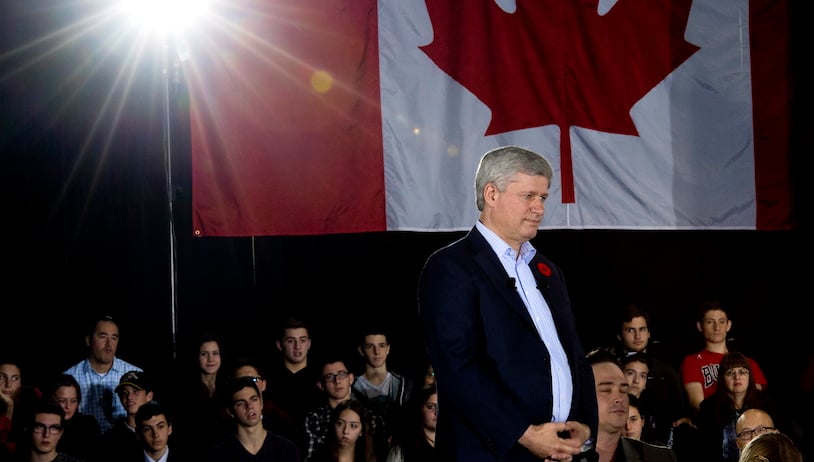Income-splitting isn’t about the rich and the rest
Middle-class benefits make it a different debate
Share

It’s not just the eyebrow-raising $2.2 billion that Stephen Harper’s “Family Tax Cut” will subtract from federal revenues every year that makes this income-splitting scheme the most controversial tax change since his government shaved a couple of points off the GST.
The very notion of income-splitting takes us out into bitterly contested ideological territory. Critics suspect, with good reason, that letting couples with kids divvy up their incomes for tax purposes is meant—even if Harper doesn’t put it this way—largely as a boon to families with a stay-at-home mom.
More often heard, though, is criticism of the Family Tax Cut from the income-inequality angle. The NDP’s website, for instance, slams it as a “giveaway to the wealthiest,” while Justin Trudeau has railed against it for handing “a tax break to Canada’s wealthiest families.”
From the time Harper announced the plan last fall, I’ve wondered exactly how much of that $2.2 billion will go to well-off households. Typically for this secretive government, Finance Minister Joe Oliver refused to tell me. His department obstinately declined to offer a simple breakdown by family income of where they expect the benefits to flow.
I finally got a projection last week from the helpful experts who work for the independent parliamentary budget officer. Combining numbers the PBO provided with some from Finance, Maclean’s has created the table you’ll see below, which I think is instructive—and a little surprising. It confirms that the policy is no good to most families at lower income levels, but a nice boost for most in the middle, and not so great as you might have been led to believe for those at the top.
The assumption that this policy’s spoils would skew wildly to the rich goes back to some early, excellent, influential analysis of income-splitting, notably the C.D. Howe Institute’s 2011 report by Alexandre Laurin and Rhys Kesselman. They forecast that 40 per cent of total benefits would go to couples with combined incomes above $125,000, with some well-off families lopping $6,400 from their tax bill.
But that study, and others like it, changed matters. Even the late Jim Flaherty, in perhaps his last important intervention as finance minister, basically said income-splitting, as promised by the Tories in the 2011 election campaign, wasn’t fair. Harper adjusted. By the time he announced the final policy last fall—allowing couples to transfer up to $50,000 of income from the higher-earning to the lower-earning spouse—the total benefit per family was capped at $2,000.
That dramatically reduced the share of tax savings funnelled to the top tier, which leaves the middle winning bigger. According to the PBO, more than 80 per cent of families with kids making $60,000 to $120,000 will gain something, saving on average about $1,200. That middle swath makes up only about a third of all families with children under 18, yet stands to collect more than half of the total benefits of income-splitting.
This is not convenient for critics of income-splitting, not one bit. It messes up the neat symmetry of their case—that it rewards the rich while slighting the poor. To oppose income-splitting while acknowledging that Harper’s version favours the middle class would be far trickier. The middle class votes.
Still, I like the way I’m forced to reconsider my own perspective. A gift to the rich that ignores the poor? I didn’t have to think hard to oppose that. But a benefit that goes disproportionately to the middle? I still can’t support it, since it continues to offer too little to those struggling hardest to get by, but I had to ponder more carefully.
Who isn’t for middle-class families? Platform jockeying in the run-up to this fall’s federal election is, as usual, shaping up as being mainly about championing them. All parties try to position themselves that way. But wouldn’t it be better, no matter which way you’re inclined to vote, to shift your focus further down the income scale?
If you’re a Conservative, and you believe in opportunity, then recognize that the least well-off—not those in the middle—most need better chances. If you’re a Liberal and you believe in balanced policy, acknowledge that society’s worst imbalances aren’t felt when you reach the middle, but while you’re stranded near the bottom. If you’re a New Democrat and you believe in government’s ability to help in areas like daycare, then look first, not at a middle class that’s muddling through, but at those who really aren’t.
The income-splitting issue hasn’t so far guilted anybody into budging off the multi-partisan middle-class fixation. Why would it have? A tax break summed up routinely by its critics as a gift to the rich, designed along social-conservative lines, doesn’t invite much genuine reflection.
But the actual effects of the policy appear to be far less stark than was imagined. Like all serious discussions about how we tax and spend, the closer we look, the less any easy rhetoric seems to fit the facts. The income-splitting debate can be reasonably framed many ways, but it isn’t just about the rich and the rest.
Who benefits (and how much) from Harper’s income splitting
[rdm-footable id=’301′]
(Sources: Finance Canada, Parliamentary Budget Office)